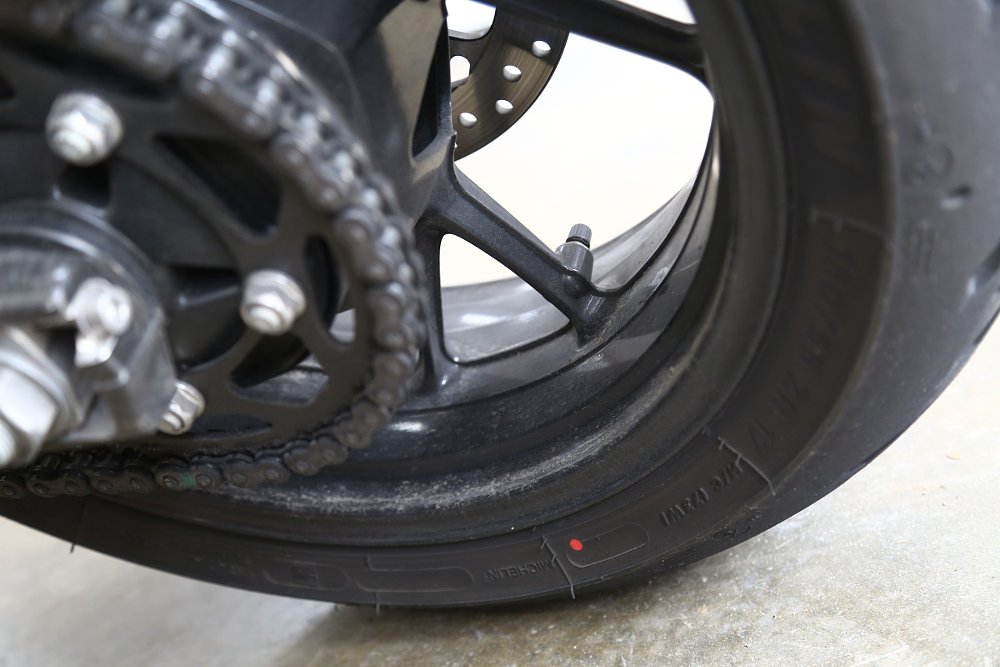Social media makes reaching out to anyone easy, which means my Instagram inbox is often full of technical questions. While I reply to (almost) everything directly on my phone, we decided to publish a few of the more general-knowledge answers here so that more folks can benefit from the info.
This installment focuses on tires, but future recaps might cover anything from suspension to valvetrain design, so check back regularly to ensure you don’t miss a concentrated dose of moto know-how. And if you’ve got a question you’d like answered, feel free to leave it in the comments section or shoot me a message on Instagram at @arihenning211.
Let’s get to the questions… and answers.
I just got new tires on my bike. The stock tires were at 32 psi, and the new Shinko 705s say 40 psi. What should I set them at? — @joshuadgrant
There’s a lot of information on your tire sidewall, from size and date of manufacture to carcass construction and country of origin. Another key piece of info imprinted in the rubber pertains to maximum load, which is where I’m guessing you got this 40 psi figure.
A tire’s maximum load — as in the most weight the tire can safely support, in case that wasn’t obvious — is dependent not only on the size and construction of the tire but also the inflation pressure, so the manufacturer spells it out. That 40 psi isn’t a recommendation, but rather a specification that only comes into play when the tire is being called upon to support all the weight it was designed to carry.
For proper comfort, traction, and wear you’ll want to run a lower pressure, ideally whatever is listed in the owner’s manual or on the sticker on your swingarm. Yes, different brand and model tires will behave differently with the same psi, but the OEM recommendation is a good baseline. And don’t forget, tire pressures should be set cold, before you ride.
For anyone who needs an explanation of the other numbers on the sidewall, check out this older RevZilla video.
I need new tires for my FZ-09 and I’m wondering what’s appropriate for day-to-day street use, no track days at all. Is the Dunlop Q3 a good option? — @m4tt_lar
The Dunlop Q3 is a tremendous tire — if you’re headed to the track or only expect to log miles attacking twisties. As a hypersport tire, the Q3 emphasizes outright grip over versatility or durability, so it’s best suited to aggressive track or street riding on clean, dry, warm pavement.
Since you’re after a day-to-day tire, I’ll tell you the same thing I tell every street rider out there, whether they’re on a Triumph Daytona 675 or a Yamaha FJR1300: Sport-touring tires offer the best balance of performance, versatility, and durability. I’ve written about this topic at length elsewhere on Common Tread so I won’t rehash it here, but suffice to say ST tires work well in a wide range of conditions (read: hot and dry or cold and wet), last a good long time, and have enough cornering traction to drag knee at the track, if you are so inclined.

Why does the red dot on the sidewall of a tire need to be aligned with the valve stem on the rim? — @dalecabz
Tire manufacturers place a red (sometimes it’s yellow) dot on the sidewall to denote the lightest point of the tire. The idea is that you orient the dot at the heaviest point of the rim, which is commonly believed to be the valve stem. Except that’s rarely the case. To fully take advantage of the dot, you’d want to throw your bare wheel on a balance stand (I use Motion Pro’s Axis stand in my garage) and determine where the heaviest point is, then align the red dot with that.
Following this technique means you’ll have better inherent balance in the rim and tire assembly, which means less weight is required to balance it. For racers or other performance-minded riders, that slight reduction in unsprung weight may be beneficial, but for street riders it really doesn’t make much of a difference. I’ll take the time to mark the heavy spot on the wheels of my race bikes, but for my street bikes I still align the dot with the valve stem, just as a matter of habit.
I’m thinking of replacing my 150/70 rear with a 150/60. What does that change and what are the effects? — @arunart96
Changing tire size changes the diameter of the tire, which in turn will affect the geometry of your bike. Different size tires also have different profiles, so the handling will further be affected beyond just the rolling diameter.
In your example, the aspect ratio, which is the height of the sidewall expressed as a percentage of the tire’s width, would drop from 70 to 60, or from about 105 mm to 90 mm, for an effective rear ride-height reduction of 7.5 mm. That’s not nothing! Lowering the rear that much will likely lead to slower, heavier steering, more high-speed stability, and of course a lower seat height and slightly reduced ground clearance.
I’ll need new tires for my 1972 Honda CB350 soon. Do you have any recommendations for a good tire that also looks somewhat correct for the period? — @pasfalldk
I’ve got the same bike in my garage, though it’s a track-only AHRMA racer so my tire criteria are a little different. Nevertheless, racing the old Honda means I’ve done a fair bit of research into the narrow 18-inch buns these bikes run, and there are a lot of options. Heidenau and Continental spring to mind, and I’m a fan of Continental’s Classic Attacks. They’re a multi-compound radial (OK to use with tubes, as tested by yours truly at over 100 mph) with an appropriate-looking tread pattern. I’ve spooned the CAs onto a few restorations I’ve done and they handle great and have excellent traction.

 Membership
Membership



